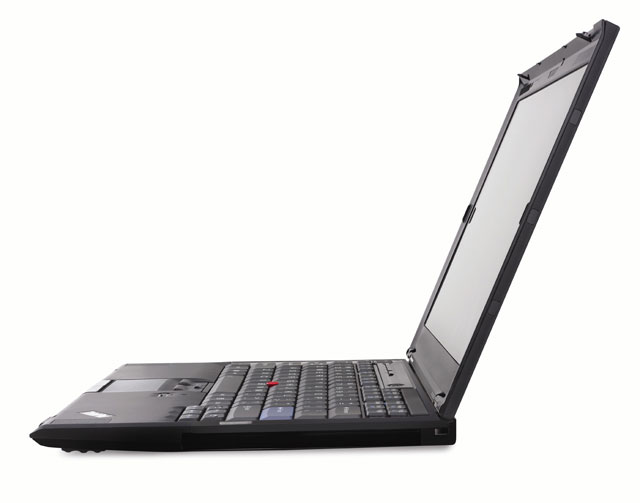Lenovo X300
Forget the MacBook Air. Is this the ultimate executive ultra-portable laptop?


It's not flawless, but when it comes to no compromise ultra-portable business notebooks the Lenovo X300 is the new reference standard.

Click here for our video review of the Lenovo X300
There aren't many laptops machines more closely associated with business than the ThinkPad range. When IBM took over from Lenovo back in 2005, there was some concern that the quality may not be kept up but that was soon proved to be dispelled with the release of the Z60t .
As such, when Lenovo announced its latest ThinkPad, the X300, expectations were high. Comparisons with the Macbook Air were obvious and inevitable, as both are a new category of notebook - both are lightweight, yet offer 13.3in displays and full size keyboards.
But compromise is a key word here. While Apple chose to make quite severe ones to achieve its , "world's thinnest laptop" tagline, Lenovo has made more reasoned choices, and as such can be said to have produced a far more practical, powerful and ultimately useful machine.
Size and shape
With the laptop closed you'll find the usual fantastic all black soft touch ThinkPad finish. Three small lights indicating power, charge and sleep states are located in one corner. Place the machine side by side and it's clear that the X300 is much more angular and functional design, but it's not one without impact.
It's also pretty darn thin at 22m, while the other dimensions are 317 x 226mm and crucially, it has a default weight of 1.45Kg. So while it's not super small in an Asus Eee PC type way, this is more than countered by the fact that it's not going to weigh your shoulder bag down too much and the large screen means that it's much easier to work with for extended periods.
Design wise, nice touches abound, such as the subtle icons that mark where the USB ports, the headphone and microphone socket and the Kensington security lock are.
Display
Opening up the X300 you'll find that 13.3in widescreen display. Not only that but it's not limited by an overly stingy display resolution, with 1,440 x 900 pixels giving appreciably more space than the 1,280 x 800 that most portable machines offer.
It is LED backlit too, which makes the screen thinner than it would be with a conventional CCFL backlight, while delivering better contrast and lower power consumption. Viewing angles aren't the best though, so you still have to tilt the screen forwards and back to get the best angle to work with.
The bezel round the screen is actually quite wide, but it does contain a 1.3 megapixel webcam, with the Lenovo UltraConnect logo next to it, which refers to the internal aerial for the a/b/g/ draft-n Wi-Fi, designed to improve reception through interference robustness.
Keyboard
As important as the screen on a notebook is the quality of the keyboard and this is where the ThinkPad range has traditionally excelled. Thankfully, it's no different here - in fact, this is as fine a keyboard as I've ever used on a portable machine. It's firm, without being too harsh and the spring of the keys is just right.
The slightly-larger-than normal for an ultraportable size of the Lenovo, means that the keyboard doesn't have to be overly cramped, making it much more comfortable to use. This means that you get a full size Enter, Backspace and right Shift key.
There are separate arrow keys under the right shift key, and there are even three curved furrows for your fingers to rest in more comfortably. There's also just the right amount of space underneath the keys on which to rest your palms while you type. And while the Lenovo lacks the undeniably cool backlit keys of the MacBook Air, there's a small light in the bezel, which is a much more basic, but still effective approach.
Get the ITPro daily newsletter
Sign up today and you will receive a free copy of our Future Focus 2025 report - the leading guidance on AI, cybersecurity and other IT challenges as per 700+ senior executives
Benny Har-Even is a twenty-year stalwart of technology journalism who is passionate about all areas of the industry, but telecoms and mobile and home entertainment are among his chief interests. He has written for many of the leading tech publications in the UK, such as PC Pro and Wired, and previously held the position of technology editor at ITPro before regularly contributing as a freelancer.
Known affectionately as a ‘geek’ to his friends, his passion has seen him land opportunities to speak about technology on BBC television broadcasts, as well as a number of speaking engagements at industry events.
-
 Westcon-Comstor and Vectra AI launch brace of new channel initiatives
Westcon-Comstor and Vectra AI launch brace of new channel initiativesNews Westcon-Comstor and Vectra AI have announced the launch of two new channel growth initiatives focused on the managed security service provider (MSSP) space and AWS Marketplace.
By Daniel Todd Published
-
 Third time lucky? Microsoft finally begins roll-out of controversial Recall feature
Third time lucky? Microsoft finally begins roll-out of controversial Recall featureNews The Windows Recall feature has been plagued by setbacks and backlash from security professionals
By Emma Woollacott Published
-
 The UK government wants quantum technology out of the lab and in the hands of enterprises
The UK government wants quantum technology out of the lab and in the hands of enterprisesNews The UK government has unveiled plans to invest £121 million in quantum computing projects in an effort to drive real-world applications and adoption rates.
By Emma Woollacott Published